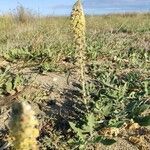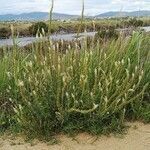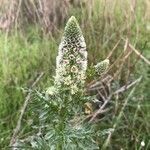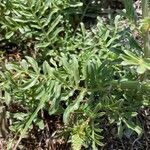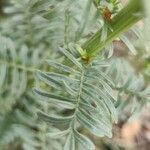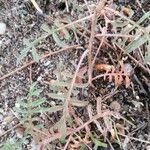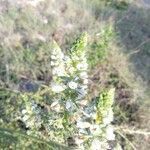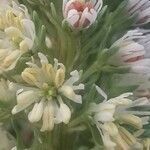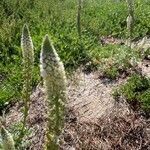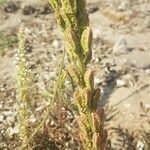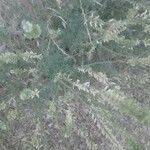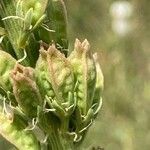Annual, rarely perennial, herb, erect or spreading, 30–70 cm high. Stem glabrous or with few deltoid papillae. Leaves pinnatifid, with 7–19 lobes; lateral lobes 4–22 mm long, 1–4 mm wide, scabrous or sometimes papillose along mid-vein; terminal lobe usually the longest, linear-elliptic, acuminate, 6–30 mm long; upper leaves smaller. Bracts linear, 2.5–4.5 mm long, glabrous, persistent; pedicels ribbed, mostly 3–4 mm long, slightly longer in fruit. Sepals 5, lanceolate, mostly 2–5 mm long, scabrous or papillose near base, persistent. Petals 5, c. 6 mm long, incised to c. 1/2, white-cream; central lobe usually longer than laterals; claw with ciliate auricles. Disc 3–4 mm wide, ciliate. Stamens 10; anthers 1.7–2 mm long; filaments persistent. Ovary 4-dentate, 4-angled. Capsule 4-angled, scabrous on ribs. Seeds granular, brown-black, dull.
Annual to perennial glabrous taprooted herb, 30-80 cm tall; rootstock woody; stems erect, ribbed, hollow, branched above. Lvs obovate-cuneate, (2)-4-10-(15) × (1)-2-5-(6) cm, pinnatifid with 5-10-(15) pairs of entire, oblong to linear lobes, constricted above lobes; margins tuberculate, flat or undulate. Pedicels patent, 2-5 mm long. Sepals 5-6, narrow-ovate. Petals white, 5-6, all with 3-(5)-lobed limbs. Stamens 11-14; filaments persistent. Capsule oblong to ellipsoid, smooth, (6)-8-12 × 2-4 mm; carpels 4. Seeds brown to dark brown, tuberculate, dull, 1-1.5 mm long.
Herbs annual or perennial, 30-90 cm tall, glabrous. Stem erect, angular. Leaves pinnatifid, papery; lobes in 5-15 pairs, linear, attenuate at base, margin entire or repand. Flowers in terminal, dense racemes. Sepals usually 5, linear, equaling pedicel. Petals usually 5, subrounded-clawed at base, 3-lobed for 1/3-2/3 their length; lateral lobes often again lobed. Stamens 11-14. Carpels 4. Capsule erect, oblong, 4-angled, 8-15 mm, apically constricted and 4-cleft. Seeds light brown, reniform, ca. 1 mm. 2n = 20, 40.
Erect, taprooted annual or perennial to 8 dm, glabrous and somewhat glaucous; lvs pinnately parted into several linear-oblong, evenly distributed, acute segments; fls greenish-white, fragrant; pet 5 or 6, commonly with 3 distinct or basally connate appendages, the central one the smallest; filaments persistent into fr; ovary and fr usually with 4 apical lobes; 2n=20. Waste places; Me. and O. to Del.; intr. from the Mediterranean region.
A herb. It is an erect annual plant. It can keep growing for a few years. It grows 30-90 cm tall. The flowers are white and in a spike. They have a scent.
